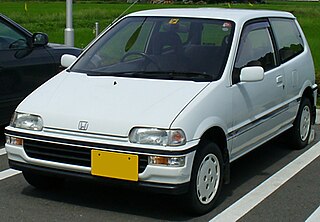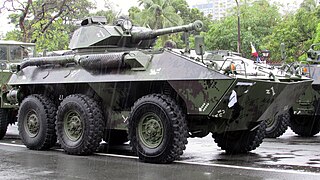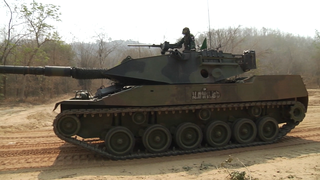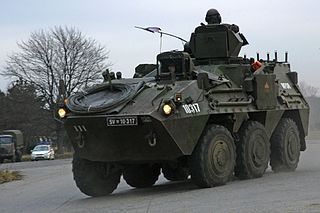
The BRDM-2 is an amphibious armoured scout car used by states that were part of the Soviet Union and its allies. It was also known under the designations BTR-40PB, BTR-40P-2 and GAZ 41-08. This vehicle, like many other Soviet designs, has been exported extensively and is in use in at least 38 countries. It was intended to replace the older BRDM-1, and has improved amphibious capabilities and better armament compared to its predecessor.

The Honda Today is a kei car produced by Japanese automaker Honda beginning in 1985. It was replaced by the Honda Life in 1998.

The Cadillac Gage Commando, frequently denoted as the M706 in U.S. military service, is an American armored car designed to be amphibious. It was engineered by Cadillac Gage specifically for the United States Military Police Corps during the Vietnam War as an armed convoy escort vehicle. The Commando was one of the first vehicles to combine the traditionally separate roles of an armored personnel carrier and a conventional armored car, much like the Soviet BTR-40. Its notable height, amphibious capability, and waterproofed engine allowed American crews to fight effectively in the jungles of Vietnam by observing their opponents over thick vegetation and fording the country's deep rivers.

The Cadillac Gage LAV-300, originally named the V-300, is a family of American light armored vehicles (LAVs) including up to 15 configurations. It was originally created and designed by CG as a private venture project.

The M1117 Guardian, also denoted Armored Security Vehicle (ASV), is an internal security vehicle based on the V-100 and V-150 Commando series of armored cars. It was developed in the late 1990s for service with the United States' Military Police Corps. The first prototypes appeared in February 1997 and serial production of the M1117 commenced between 1999 and early 2000.

The Stingray, sometimes known as the Commando Stingray, is a light tank produced by Textron Marine & Land Systems division. It was specifically designed to use as many existing components of other American armored fighting vehicles as possible to keep costs down. The Stingray was a private venture project aimed at foreign countries. As of 2020, Textron has kept the Stingray name registered.

The Cadillac Gage Ranger is a four-wheeled armored personnel carrier produced by Cadillac Gage, built on a Dodge truck chassis. The largest customer was the United States Air Force, which the Ranger was marketed to in order to meet needed requirements as a security/patrol vehicle.

The Dragoon 300 AFV was produced by Arrowpointe Corporation during the 1980s. It was based on the automotive components of the United States Army's M113 APCs and 5-ton trucks. It resembles a larger V-150 Commando.

Lahko kolesno oklepno vozilo Valuk is an improved version of Pandur 6X6 APC, manufactured under a license manufacturing agreement with the Austrian company, Steyr Daimler Puch Spezialfahrzeug AG & Co KG, by Sistemska Tehnika of Slovenia for the Slovenian Army.
The Mohafiz is a family of internal security vehicles designed and manufactured by Heavy Industries Taxila with Cavalier Group also designing later production models.
The MX-8 Armored Escort Vehicle was an experimental armored vehicle developed by Philippine steelworks fabricator Steelcraft Industrial & Development Corporation, in collaboration with the Philippine Army, arising from a need by the latter for smaller, tougher armored vehicle that can fill an escort role larger armored vehicles cannot; a consideration confined Philippine jungles aggravated. MX-8 stands for "Military Experimental 8", following from a list of prototype vehicles developed by Steelcraft during the latter half of the 20th century. The Philippine Army has expressed significant interest in the project, helping to bankroll a few aspects of the prototypes, indicating intent to purchase a number units once the MX-8 has exited the development stage.

The Mitsubishi Type 89 IFV(89 FV ) is a Japanese infantry fighting vehicle that entered service with the Japan Ground Self-Defense Force in 1989. There were 58 vehicles in service as of 1999 and a total of 120 produced by 2014 with 300 planned. The main armament of the vehicle is an Oerlikon Contraves 35 millimeter KDE cannon.

The D-442 FUG and D-944 PSZH are the results of Hungarian domestic development of relatively cheap amphibious armoured scout car and armored personnel carrier series. FUG and PSZH were exported with limited success, thus it is also known under its Czechoslovak designation OT-65.
The Cadillac Gage LAV-600, also known as the V-600, is an American light armored 6×6 wheeled vehicle, derived from the LAV-300. Developed by Cadillac Gage as a private venture project, the LAV-600 offers superior firepower and mobility to the LAV-300, normally being equipped with a 105mm main gun.
The Cadillac Gage Peacekeeper II is a four-wheeled, lightly armoured vehicle, developed by Textron Marine and Land Systems. The Peacekeeper II is designed primarily for the use of law enforcement agencies in urban environments for SWAT operations, base security, convoy protection, counter-terrorism and riot control. The vehicle is an evolution of the Cadillac Gage Ranger.

The Type 85 is a tracked armoured fighting vehicle produced by Chinese company Norinco. It is an improved version of the Type 63 armoured personnel carrier. The vehicle is bigger, has additional firing ports and periscopes, a longer chassis with an additional road wheel on each side, and is equipped with an NBC protection system.

The Type 90 is an armoured fighting vehicle produced by Chinese company Norinco; it is the successor for the Type 85 AFV of which it uses some components. The Type 90 series was developed for export, and consists of at least 10 different types; its industrial index is YW535.

The MOWAG Shark is an armored personnel carrier produced by the MOWAG Motor Car Factory, Kreuzlingen, Switzerland.

The Panther KF51 is a German main battle tank (MBT) that is under development by Rheinmetall Landsysteme. It was unveiled publicly at the Eurosatory defence exhibition on 13 June 2022. KF is short for "Kettenfahrzeug", the German word for "tracked vehicle".














